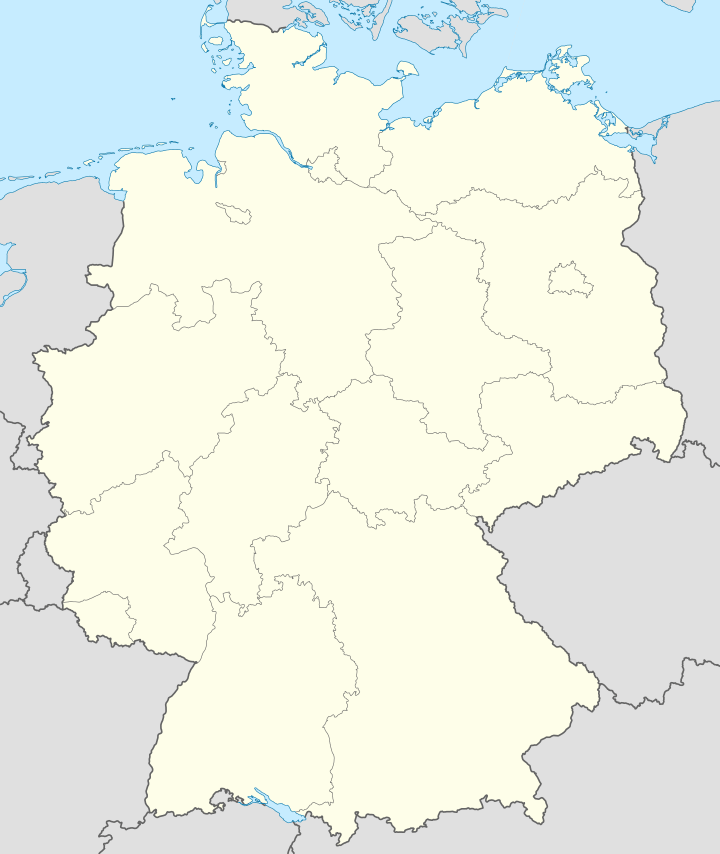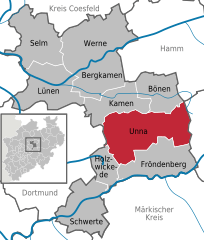Unna
| Unna | ||
|---|---|---|
|
The Old Market in Unna. | ||
| ||
 Unna | ||
Location of Unna within Unna district 
 | ||
| Coordinates: 51°32′05″N 7°41′20″E / 51.53472°N 7.68889°ECoordinates: 51°32′05″N 7°41′20″E / 51.53472°N 7.68889°E | ||
| Country | Germany | |
| State | North Rhine-Westphalia | |
| Admin. region | Arnsberg | |
| District | Unna | |
| Government | ||
| • Mayor | Werner Kolter (SPD) | |
| Area | ||
| • Total | 88.52 km2 (34.18 sq mi) | |
| Population (2013-12-31)[1] | ||
| • Total | 58,856 | |
| • Density | 660/km2 (1,700/sq mi) | |
| Time zone | CET/CEST (UTC+1/+2) | |
| Postal codes | 59423, 59425, 59427 | |
| Dialling codes | 02303, 02308 | |
| Vehicle registration | UN | |
| Website | www.unna.de | |
Unna is a town of around 67,000 people in North Rhine-Westphalia, Germany, the seat of the Unna district.
Geography
Unna is situated on an ancient salt-trading route, the Hellweg road. Trade on this route and during the period of the Hansa Trade Route came from as far as London. It is located at the eastern extremity of the Ruhr area, about 15 kilometres (9 miles) east of the centre of Dortmund.
Division of the town
Unna consists of the following districts:
|
|
Massen and Königsborn are industrial and mining areas; the other districts have a more rural character.
History
The history of Unna is a long series of wars, plagues, and fires.
There were neolithic settlements here but Unna gained significance as a way station on the Hellweg. Its name is first recorded in an ecclesiastical document of 1032. Around 1200, Count Friedrich von Altena-Isenberg was invested with the fiefdom of Unna, among other estates, by the Archbishop of Cologne. Over the next few hundred years the town was repeatedly fought over, and burned down several times. In the 14th century the town became wealthy: a mint was established and in 1952 a selection of coins numbering around 70 were discovered during excavation works. The coins originated from various countries and are thought to have been buried around 1375. From the mid 15th century the town was a notable trade centre and Hanse town. In 1597 more than half the population died of the plague. In the early 17th century the town changed hands several times in religious wars, and in 1666 fell under the control of Prussia. In the early 19th century the primary character of the town started to change from agricultural to industrial, with improved communications by road, rail and waterways. Coal mining started in 1870, together with industries dependent on it. The population rose from around 2,500 at the start of the 19th century to 15,000 in 1900. In 1943-45 there were major air attacks directed at the significant barracks and other military installations in the town.
In the older part of town are many half-timbered buildings built between the 16th and 19th centuries. Unna was an agriculturally based town until the 19th century, when it became industrially based. After World War II the artisan district which had survived bombing was largely torn down to make way for modern development; however many of the buildings have been restored.
The Lindenbrauerei once produced Lindenbier, and restarted small-scale production a few years ago. The brewery is also home to the town library and night school (Volkshochschule). It is characterised by its large chimney stack which boasts a light installation, not surprising considering the brewery houses the centre for International Light/Illumination Art (Zentrum für Internationale Lichtkunst).
Culture
Unna holds the largest Italian festival north of Italy every two years, when buildings are decorated with light installations by artists from Bari in Italy.
In common with other German towns, Unna produces its own traditional herbal liquor, 'Herting Pörter', named after the town's Herting gate or 'port'. Parts of the town wall remain intact and in good condition, and include towers near the artisan quarter. The liquor is produced near where the gate used to be, and is sold locally.
In the market place is a fountain with a man pulling a stubborn donkey, which is the town mascot, perhaps because the locals consider themselves stubborn. The market place hosts the Stadtfest every September and the Italian light festival mentioned above. There is also a grocers' market. The square hosts the Christmas market which goes from the square down the Bahnhofstraße to the Rathaus (Town Hall).
The newly refurbished Unna station has trains to all major cities in North Rhine Westphalia including Dortmund, Cologne, Münster, Hamm, Düsseldorf and Wuppertal. There is also the Regional-Express 7 (Rhein-Münsterland-Express) runs from Rheine via Cologne to Krefeld.
The recreational district of Sauerland is nearby. The River Ruhr runs just south of Unna through Fröndenberg before heading through the main section of the Ruhr District (Ruhrgebiet).
Local dialects of German include Westfälisch and Ruhrpott.
More pictures of Unna are in the German Wikipedia page about Unna.
Economy
Till the mid-nineteenth century the focus of Unna's economy was on the region's agriculture. Industrialisation rapidly followed. In contrast with the switch to service sector employment in some of the industrial towns further west in the Ruhr area, most of the jobs in Unna are still in heavy industry (iron and metal work, machine manufacturing) or craft based.
In recent years Unna has boomed as a logistics centre. It contains the former distribution centre for the (recently much diminished) Karstadt department store chain: the distribution centre has been acquired by the DHL division of Deutsche Post. There is also a DPD distribution centre along with a central distribution depot for the pump producer Wilo. Another large logistics complex belonging to DHL came into operation in 2008.
Unna also serves as a dormitory town, being home to many commuters who work in the big industrial Ruhr region towns and cities nearby.
International relations
Twin towns — Sister cities
Unna is twinned with:[2]
Gallery
-

City church with evening lighting
-
.jpg)
Donkey fountain in the town square (Josef Baron)
-

Church of St Catherine
-

Former Brewery (Lindenbrauerei)
References
- Notes
- ↑ "Amtliche Bevölkerungszahlen". Landesbetrieb Information und Technik NRW (in German). 4 September 2014.
- ↑ 2.0 2.1 2.2 2.3 2.4 2.5 "List of Twin Towns in the Ruhr District" (PDF). © 2009 Twins2010.com. Retrieved 2009-10-28.
- ↑ "Pisa - Official Sister Cities". © Comune di Pisa, Via degli Uffizi, 1 - 56100 Pisa centralino: +39 050 910111. Retrieved 2008-12-16.
External links
| Wikimedia Commons has media related to Unna. |
| Wikisource has the text of the 1911 Encyclopædia Britannica article Unna. |
- Official website (German)
| ||||||||||||||||||||||||||||||||||||||||||||||||||||||||
| ||||||||


